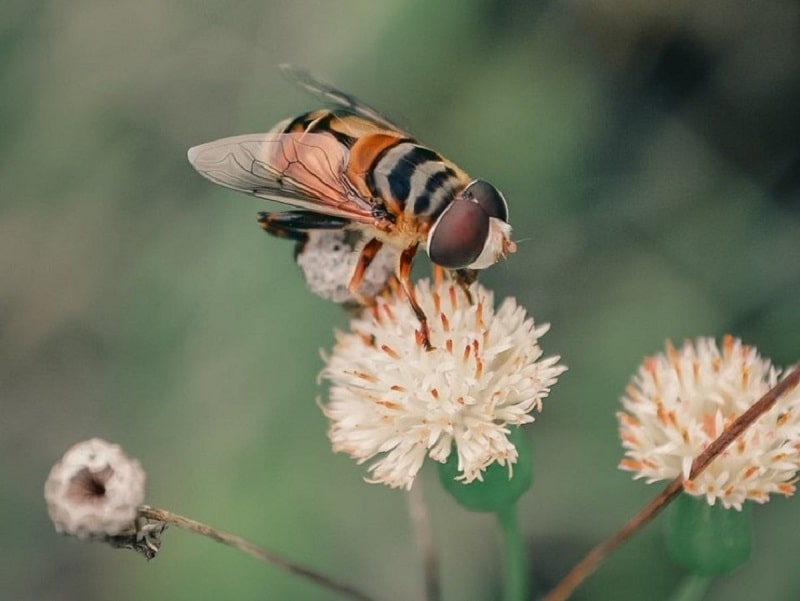You run into honey bees everywhere: At your pool, in the streets, and in the gardens while hunting for nectar. You can see honey bees everywhere. Have you ever tried to follow them around to see where they go? Or how far will honey bees fly from their hive?
There are numerous bee species, each with its own set of travel patterns, flying speeds, and distance ranges. To get the most out of your hive as a beekeeper, situate it near local flora or in your bee-friendly flower garden. To accomplish this, you must first understand the traveling pattern and maximum trip distance of your bee species.
How far can honey bees fly away from their hive?
Honey bees often fly across vast swaths of land in search of pollen and nectar. Given their little bee bodies, the area may appear fairly large. With a typical foraging distance of 1–2 miles from their hive, varied situations can lead to lengthier flights. So, what is the maximum distance honey bees may go from their hive? They will go as far as they need to in order to obtain the necessary resources for the colony.
The majority of bee species on the planet are solitary bees. They live alone and have children without the assistance of a huge family. In general, this sort of bee does not need to travel far from home to feed. Despite the fact that sociable Bumble bees may fly a longer distance, most species forage within a mile of their colony.
A honey bee colony, on the other hand, is a massive social organism that relies on the labor of thousands of people to supply resources for the family. As a result, they will travel much further away from home in search of supplies. It takes a lot of effort to feed everyone in the family.

Bees travel long distances for food.
How far will worker bees travel for food? This is a typical worry among beekeepers who want to grow flowers for their hives.
The distance between a food source and the hive is significant in colony formation. The closer food is to the hive, the more bees may collect in a given amount of time. Honey bees can travel a greater distance in search of nourishment. The majority of foraging, however, occurs within a mile or two of the hive. Because they avoid travel time, the colony can collect more food in less time.
When a healthy adult honey bee first leaves the hive, it flies at roughly 15-20 mph. She will fly significantly slower if she is loaded down with honey, pollen, or water — perhaps around 12 mph.
How far do honey bees travel for water?
Honey bees, too, require water! And, similar to nectar collectors, they will fly up to 4-5 kilometers away to find a suitable water source. What the bees consider proper may not be the same as what we consider proper. They will collect water from any damp surface, even if the water is of poor quality.
This is why beekeepers with beehives must supply an appropriate water source for their bees. Native bees require water as well, but in fewer quantities than a honey bee hive. It is a good idea to have a steady water source in your bee-friendly garden.
How far do bees travel in their life?
Too many variables come into play when attempting to determine how far a bee travels in its lifespan. The amount of feed available near the hive, the weather, and the health and age of the bees all have an impact.
In her lifespan, the ordinary worker honey bee will only produce about 1/12 teaspoons of honey. This is why it takes such a many individual bees to support the colony. However, if one bee could do it all, it is predicted that she would have to go 50,000 – 90,000 kilometers to produce one pound of honey.

>>> Read more: Best Honey Extractors Review 2021
How high can honey bees fly?
Honey bees have the ability to soar fairly high above the ground. The air would become colder at greater elevations, which would be a limiting issue. Once the temperature goes too low, the bees would be unable to keep enough heat in their flying muscles to stay aloft.
Do human activities affect a bee’s traveling plans?
To understand how far bees go for food and water, you must be aware of the external variables that have a detrimental impact on them. For example, the use of pesticides tends to impair a bee’s natural activity and flight pattern. It also has a significant impact on their ability to hunt for pollen, nectar, and water.
Pesticide use on agricultural fields must also account for bee flying patterns. The beekeeper who provides pollination in a field wants to ensure that the farmer does not spray toxic chemicals too close to the beehives.
Bees are also harmed by EMF and radiation from technology. They disrupt bees’ inherent compass, making it difficult for bees to travel appropriately and safely. The situation is just as bad for the bees as it is for us because it affects the agricultural landscape and the food supply.

Conclusion
Most bee species have a well-defined migratory range for food and water. Some, such as honeybees and bumblebees, can fly considerable distances in optimal conditions. Others, like solitary bees, fly shorter distances due to energy limits and safety considerations. Understanding how far bees fly on average also assists farmers in determining how many hives are required to pollinate a specific size field or fields.
>>> Related Posts:
